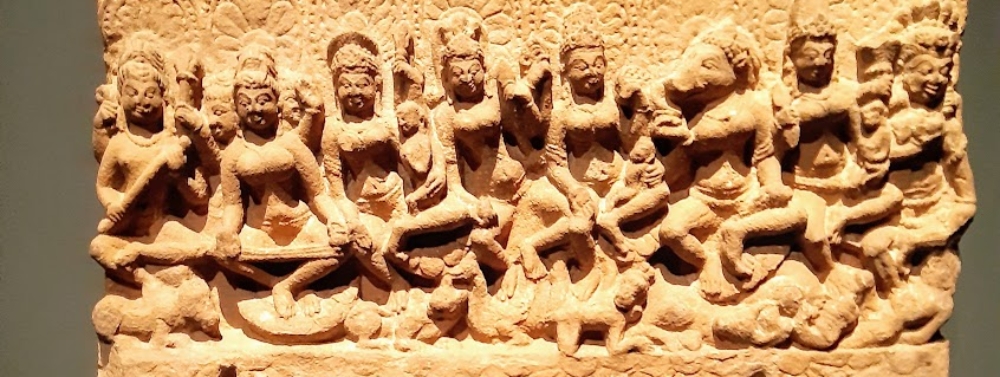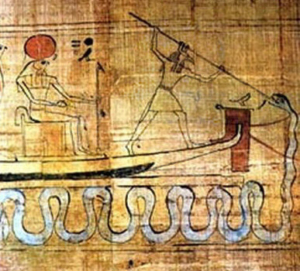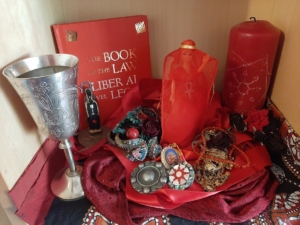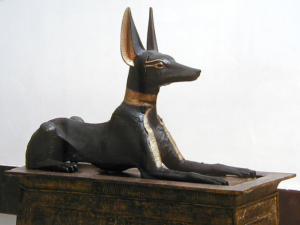
The Anubis ritual is based on an ancient Egyptian ritual which is similar to a seance. The priest/ess of Anubis invokes Anubis’s Godform into the medium which will channel Anubis’s knowledge concerning the other deities which will be invited into the “table”.
This year we invite to the table: Geb the God of the Earth, and Nuit – the Goddess of the sky (Geb & Nuit are lovers and the parents of Osiris, Set, Isis, Nephtis and Horus the Elder). As is the time of Green Magick we also think that we have to invite the God Min – which is the most ancient form of the God Pan.
Min
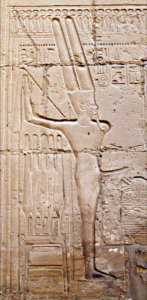
Min is an ancient Egyptian god whose cult originated in the predynastic period (4th millennium BCE). He was represented in many different forms but was most often represented in male human form, shown with an erect penis which he holds in his right hand and an upheld left arm holding a flail.
As the central deity of fertility and possibly orgiastic rites, Min became identified by the Greeks with the god Pan. One feature of Min worship was the wild prickly lettuce Lactuca serriola (the domestic version of which is Lactuca sativa (lettuce)), which has aphrodisiac and opiate qualities and produces latex when cut, possibly identified with semen.
Celebrations of Min’s birthday are recorded on Egypt’s oldest memorials such as the 1st Dynasty Palermo stone. But his cult is even older reaching back to the prehistoric era when he was a deity of fertility, sexual reproduction and natural phenomena such as storms. His erection is his most famous attribute — combined as it is with his raised arm and flail some have speculated that this is all part of an aggressive/protective posture.
His main centres were Koptos (Kuft) & Panopolis (Akhmim). His symbols are the Thunderbolt, the White Bull, the Flail and the Phallus. Wallis Budge speculates there was also a lunar component to his cult. Min is also called ka-mwt-f “Bull of his mother” a reference to the incestuous impregnation of his mother, an epithet of various gods, including Horus, also Geb who kills his father Shu in order to ravage Tefnut. Before getting too outraged, it’s as well to remember this is an agricultural motif and refers to the reproductive activity of bulls and cows. Min’s archaic shrine was a phallic-shaped hut, woven from two significant and emblematic plants — the White Lotus & the (narcotic) Blue Lily (Nymphaea caerulea).
The blossoms and foliage of these flowers are to be woven into a model phallus or perhaps a crown. The traditional hymns are referred to as “Danced”, implying they are rhythmic chants.
Danced Hymn for Min
who is on his staircase
Hail to you,
Min, Min Ra
Welcome
On your staircase
Hail to you
Min, Min Ra
And the crown you wear
on your forehead
Hail to you
Mysterious Min
“Bull of his mother”
Much that you do remains in obscurity
You are unique
To whom praise is given
You have power to give life
To those you love
Powerful to give him to be propitiated
He is unique here
To whom has been conferred the function
of the unknown god
While you go out of the great door
And are standing on your stairway of truth
Speaking with Osiris hour by hour
See, that which you ordain
For protection
Against all bad things
Min justified before your enemies
In the sky and on the earth
By the judges of all the gods
And all the goddesses.
NWT/ NUT/ NUIT & GEB
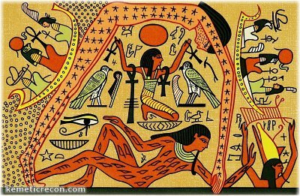
Nuit is the daughter of Shu and Tefnut. Her brother and husband is Geb. She had five children – Osiris, Set, Isis, Nephthys and Horus the Elder. She is considered one of the oldest deities in the Egyptian pantheon, with her origin being found in the creation story of Heliopolis.
Her name means “The watery one” which may also symbolize the uterus. She represents the sky but not as the lifeless roof of heaven but as a dynamic entity, creating and destroying. She also represented the entire sky. Night and day as well as large features such as the Milky Way.
The female sky is the realm of the dead, whereas the Earth is for the living. This perhaps explains the male rulership of the Earth.
Nuit is intimately connected with the stars, especially those that are close to and appear to envelop our world. According to The Book of NWT, creation begins with the ambisexual Amun-Ra or Sungod Ra. he has the power to emanate part of himself, creating other Gods and Goddesses. He starts with Shu and Tefnut, who represent the principles of air and fire respectively. The process of emanation continues and they generate NWT the sky Goddess and Geb the Earth.
Nwt and Geb are locked together in a sexual embrace, almost a single entity. It is Shu, the God of the winds and the air who separates them, creating a space between all these elements in which our world can exist.
Geb was the Egyptian god of the earth and a mythological member of the Ennead of Heliopolis. He could also be considered a father of snakes. It was believed in ancient Egypt that Geb’s laughter created earthquakes and that he allowed crops to grow.
The oldest representation in a fragmentary relief of the god was as an anthropomorphic bearded being accompanied by his name, dating from king Djoser’s reign, 3rd Dynasty, and was found in Heliopolis. However, the god never received a temple of his own. In later times he could also be depicted as a ram, a bull or a crocodile.
Geb was frequently feared as the father of snakes (one of the names for snake was s3-t3 – “son of the earth”). In a Coffin Texts spell Geb was described as the father of the mythological snake Nehebkau of primaeval times. Geb could also be regarded as personified fertile earth and barren desert.
In the Heliopolitan Ennead (a group of nine gods created in the beginning by the one god Atum or Ra), Geb is the husband of Nwt, the sky or visible daytime and nightly firmament, the son of the earlier primordial elements Tefnut (moisture) and Shu (“emptiness”), and the father to the five lesser gods of the system – Osiris, Seth, Isis, Nephthys and Horus the Elder. In this context, Geb was believed to have originally been engaged with Nut and had to be separated from her by Shu, the god of the air. Consequently, in mythological depictions, Geb was shown as a man reclining, sometimes with his phallus still pointed towards Nwt. Geb and Nut together formed the permanent boundary between the primaeval waters and the newly created world.
His association with vegetation, healing and sometimes with the underworld and royalty brought Geb the occasional interpretation that he was the husband of Renenutet, a minor goddess of the harvest and also a mythological caretaker (the meaning of her name is “nursing snake”) of the young king in the shape of a cobra, who herself could also be regarded as the mother of Nehebkau, a primaeval snake god associated with the underworld.
Sources:
Egyptian magick (Morgan: 2021)
Demonic Calendar (Morgan: 2021)
